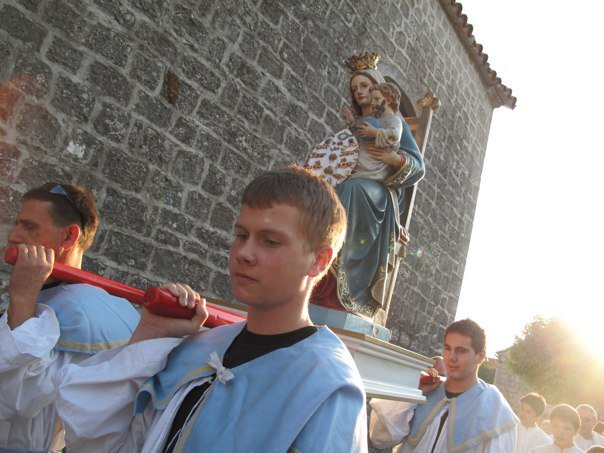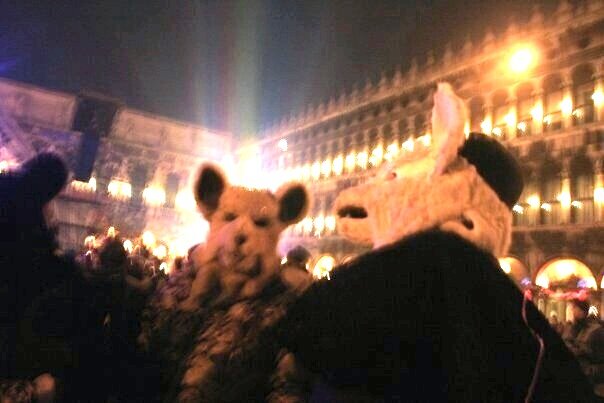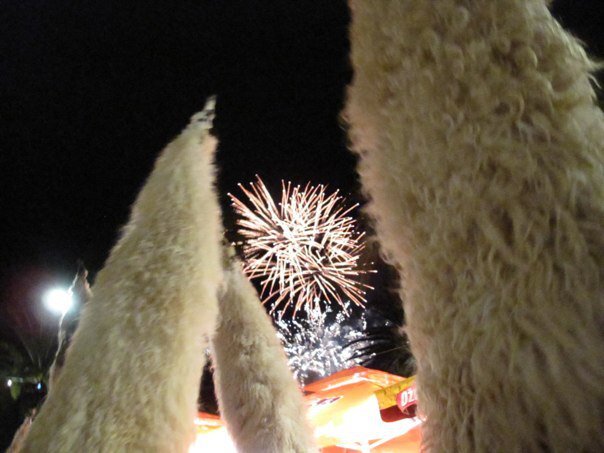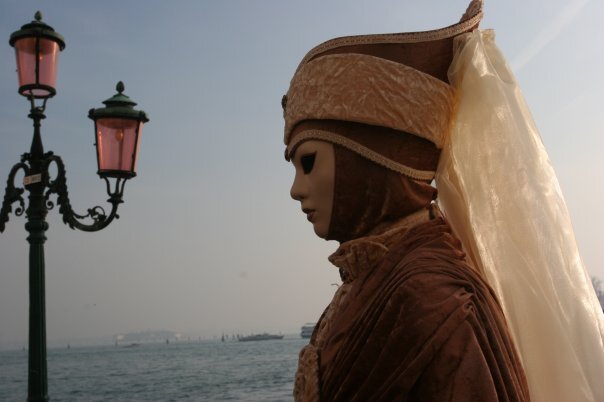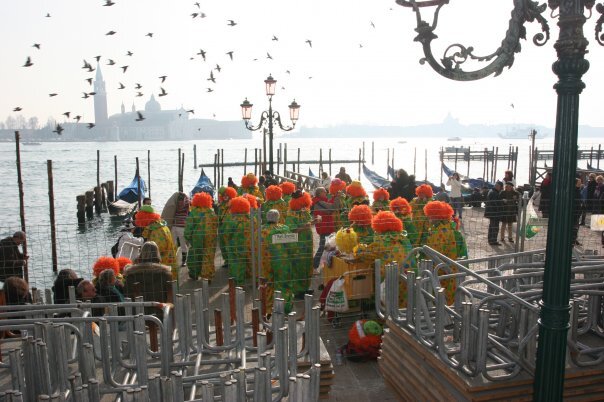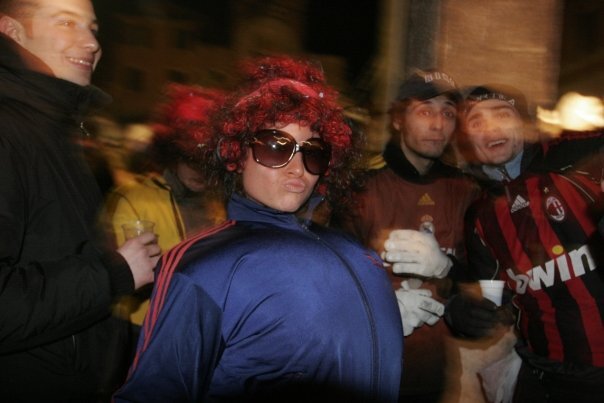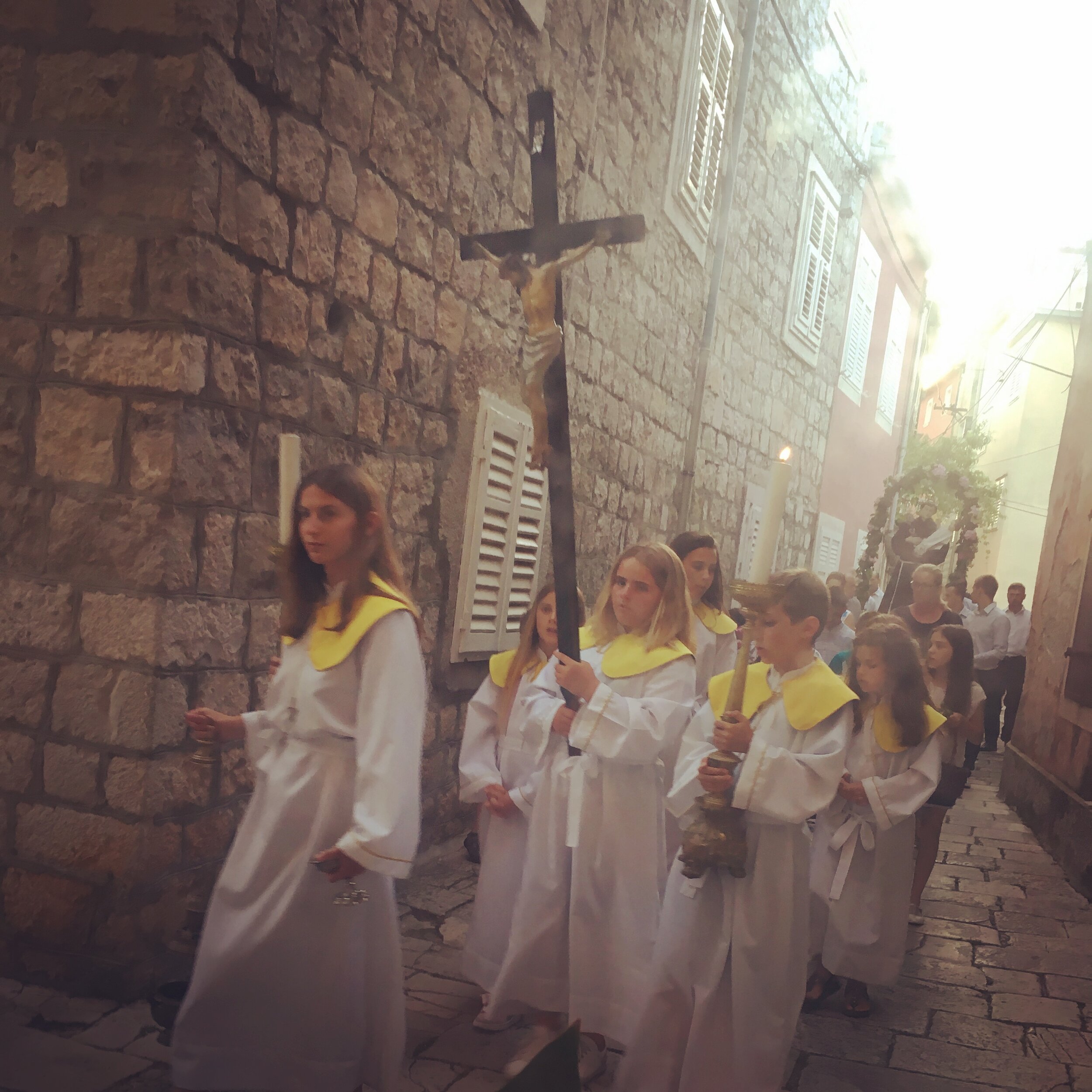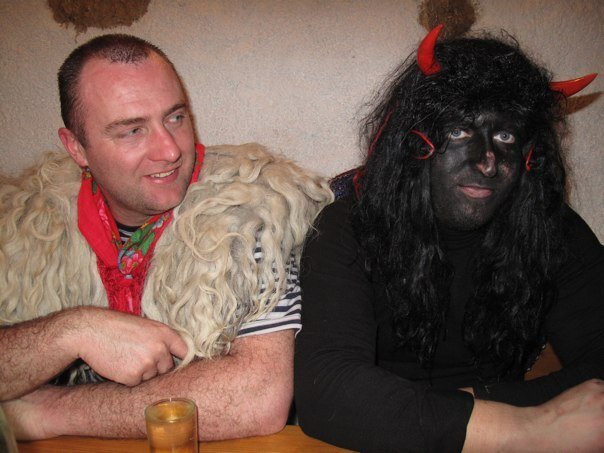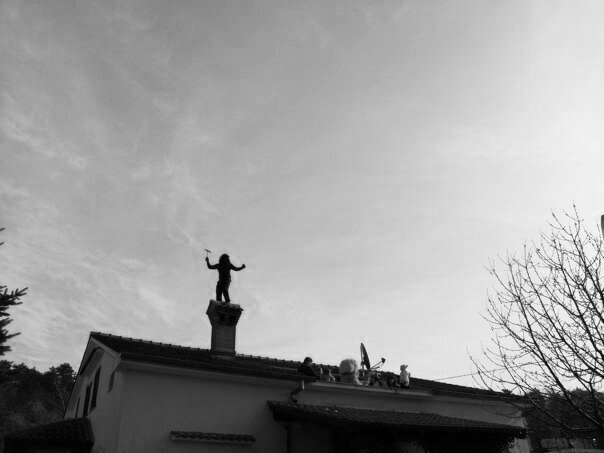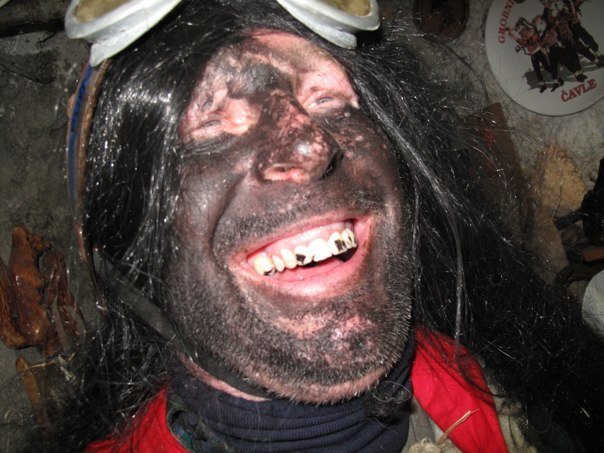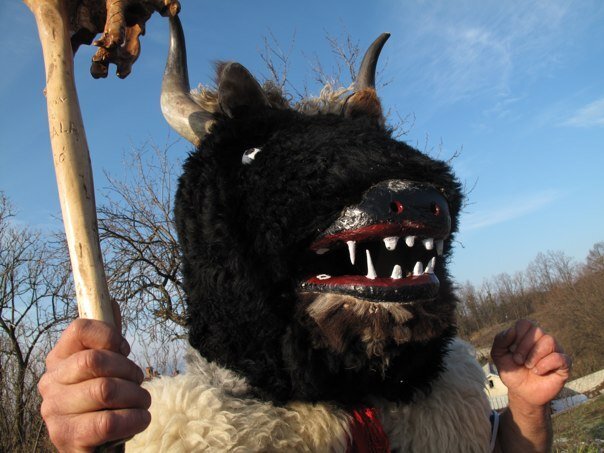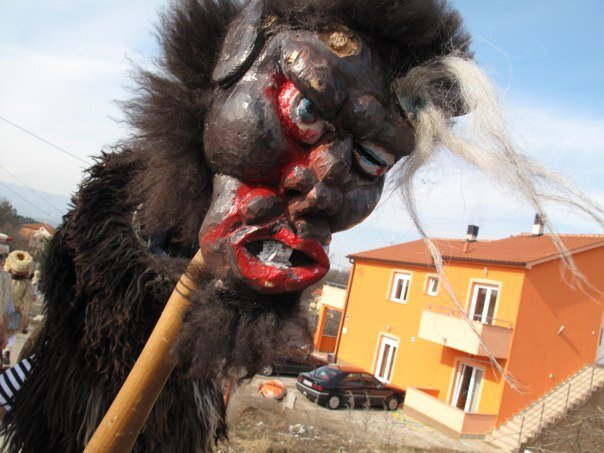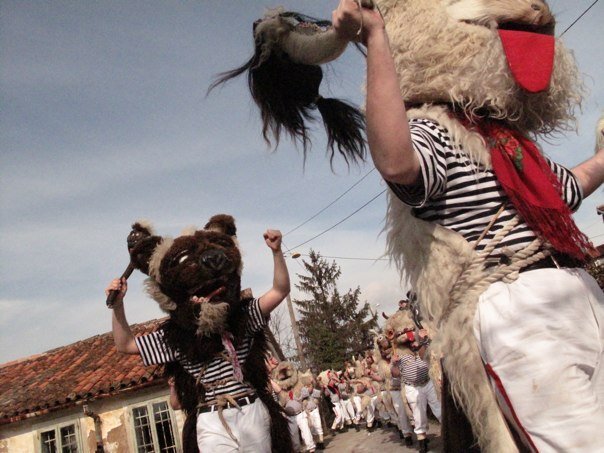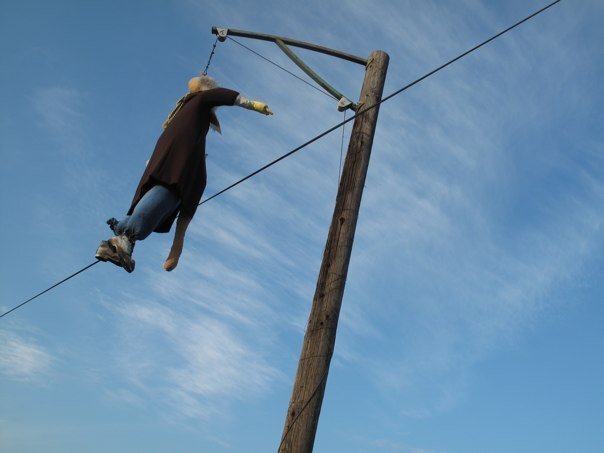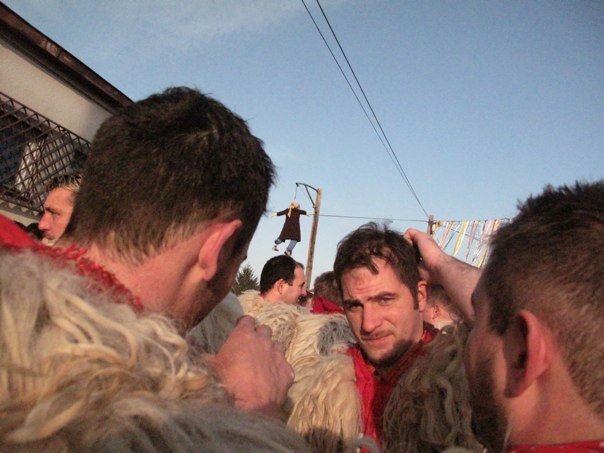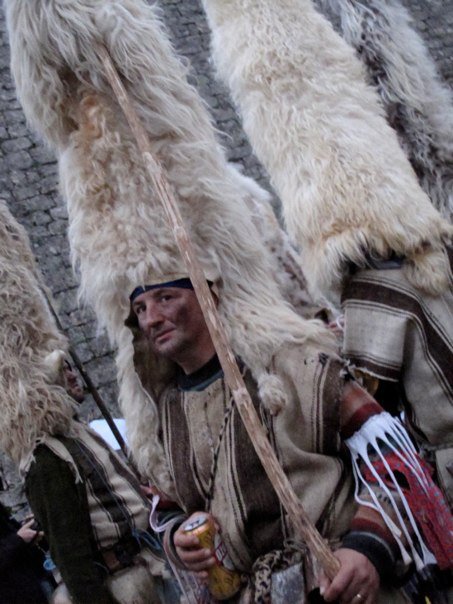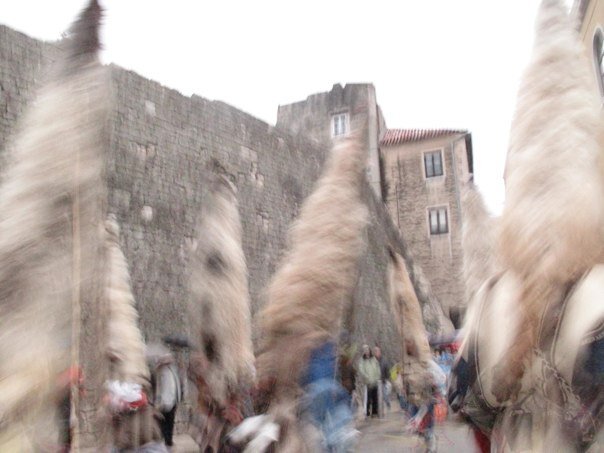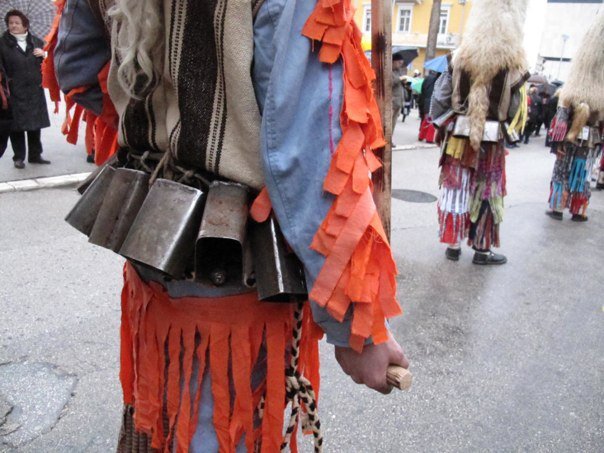“Within minutes we found ourselves in a circle of creatures - a boisterous flock of men draped in sheepskin, and at this point holding under their arms, enormous fantastical hairy and bloody toothed, horned heads. Heads that they would soon heave up and onto their shoulders transforming themselves from the friendly guys offering me rakija at 8am; into beasts from another world... ”
The documentarian in me has always been drawn to festivals, masquerades, processions, carnivals...pretty much anything that involves celebrations en masse - I am sure to find something that catches my eye. I’m not always exploring the mountains after all!
A festival; especially a carnival procession, is a moving street theatre. A blast of culture, humanity and creative expression. And just as much about the parades and costumes; it is about the audience.
People watching at its best!
Guca Trumpet festival, Serbia
Festivals offer an insight into the culture and traditions of a place; and for a visitor, an open invitation for everyone to join in on the party.
The foundation for many celebrations is often linked to the past; giving history and heritage a fighting chance to be carried on over the years.
I am writing this on the day that marks almost a year of COVID lockdowns, and life as we knew it is a distant story of the past…
Most of all though - I miss my old self and the results of my spontaneous, last minute adventures.
One such plan was hatched mid February 2011, when I spotted a newspaper story about the Rijeka carnival.
I had two days.
I packed my cameras, and the next morning caught the bus north from Split, to the other end of the coast and the city of Rijeka; with plans to check out the famous Rijeka Carnival parade and festivities.
One of the largest and longest running carnivals in Europe, it is a beloved event of the year for Rijeka citizens during which the whole city comes out to revel, rock, and ready themselves for the stretch of Lenten abstinence that follows and lasts until Easter - 46 days…that is if you adhere to Roman Catholic ideals.
Venice carnival
Yearly Shrovetide celebrations take place amongst Christian cultures across the globe; celebrated in a multitude of ways.
In Croatia, and other catholic countries such as Italy, Spain, Brazil; this period is expressed by way of the carnival (karneval) season, beginning in January (Epiphany) and coming to a grand end the night before Ash Wednesday.
All dates are defined by when the feast of all feasts falls - Easter. When one is allowed to exit from their fasting, after the period when one quits meat amongst other vices like alcohol, sweets, and decadent things. Theories suggest carnival is connected to the latin expression - carnem lavare (to leave the meat).
The tradition of dressing up, in masquerade fashion, and the underlying purpose of scaring off evil, ills and the chills of winter is also the common thread that runs through carnival time.
Saying farewell to winter, and crossing over to spring, from darkness to light, where all the magic happens. There is nothing more fitting than a fest, a feast, a few Pagan rites - and a good blast of debauchery. Celebrate spring, and send yourself off into the abyss of absolving your sins.
A HAPPY HAPPENSTANCE
On my first evening in Rijeka I dropped in at a gathering at a local pub. I started chatting to one of the attendees, a Croatian photographer. When I mentioned I had come to Rijeka to get some shots of the carnival celebrations and parade, he immediately said,
“well, you need to come with me if you want some good photos. Meet me tomorrow at 7am”.
It was a chilly morning as we piled into the car and headed up winding roads to the hills above Rijeka to the Kastavian region, and a cluster of small villages known for their remarkable carnival traditions, and the iconic Haljubajski Zvoncari.
Within minutes of parking we found ourselves in a circle of creatures. A boisterous ‘flock’ of men draped in hairy swaths of sheepskin; and at this point holding under their arms, enormous fantastical bloody toothed, horned, beastly heads. Heads that they would soon heave up and onto their own shoulders transforming themselves from the friendly guys offering me rakija at 8am; into whimsical beasts from another world...
THE MARCH OF THE HALJUBAJSKI ZVONČARI
An ancient folk tradition, and yearly carnival ritual, the march of the Haljubajski Zvončari has literally marched its way through the centuries from its Pagan Antiquity roots to its cherished position as an intangible cultural heritage tradition recognized by UNESCO in 2009.
Many Slavic cultures have giant beast figures, bells and ritualistic marches in their carnival pageantry - defined by certain elements in their costumes. There are even differences found within Dalmatia, and within this small region. Some villages have switched out the mask for hats adorned with ribbons and colourful flowers - a historical leftover from WWll, when masks were prohibited, resulting in some of villages letting go of the tradition. Closer to Split; bellringers wear surreal conical, meters high, pointed towers of sheepskin - but no mask.
Playing an iconic role in the Rijeka carnival; the Zvončari groups help keep the village traditions of the region from fading away, passing on the honour and tradition to the younger generation of men.
Both the Rijeaka carnival and the folkloric traditions came near to extinction, but tradition prevailed and the costume balls, the parades, and the beasts rose from their forced slumber to revel and march again. The Haljubajski Zvončari were one of the groups that took it upon themselves to revive the Rijeka carnival from the ashes.
THE LOOK, THE PROPS,
THE PERSONAL TOUCHES
Their costumes are definately show stealing. The merrymaking, big bellied wildebeest monsters of the hills…
Handcrafted and stylized by the wearer, the iconic monstrous heads are horned, hairy, bloody toothed with tongues flopping about. Each one is the unique design of its wearer, and I spotted some humour in some of the personal touches - “knife in eyeball” was my favourite pick of the bunch.
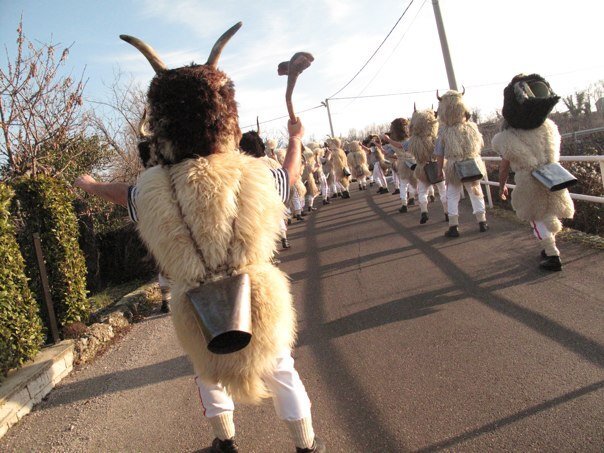
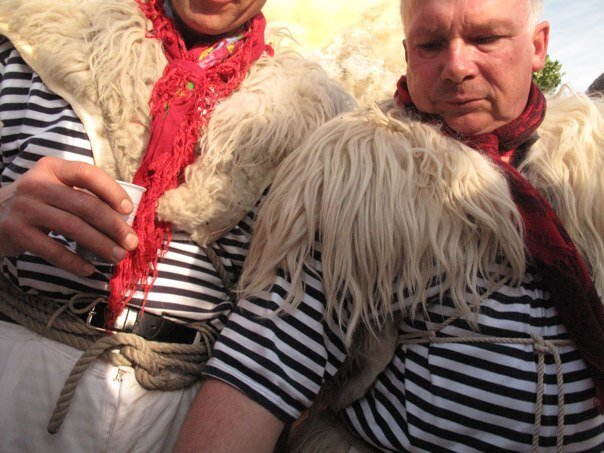
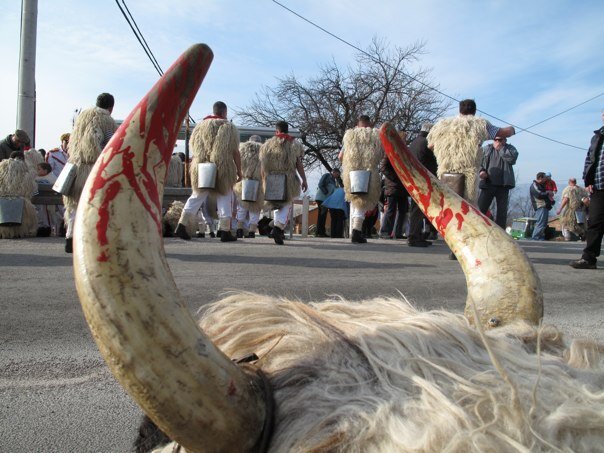
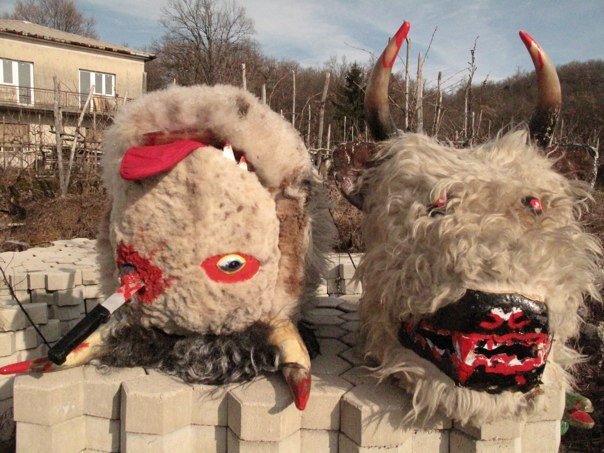
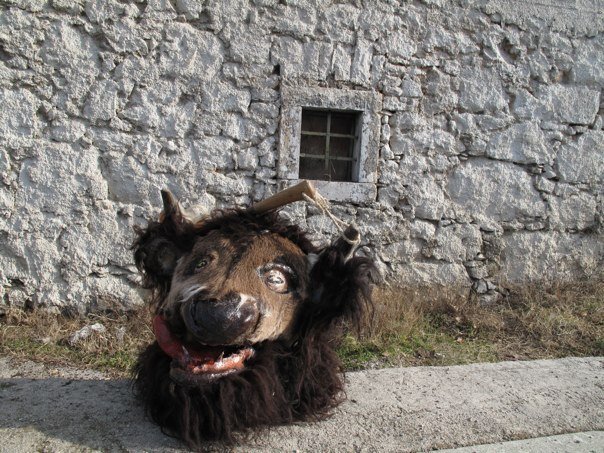
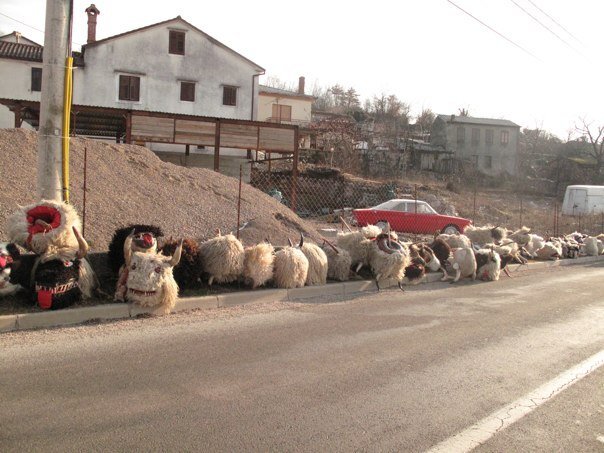
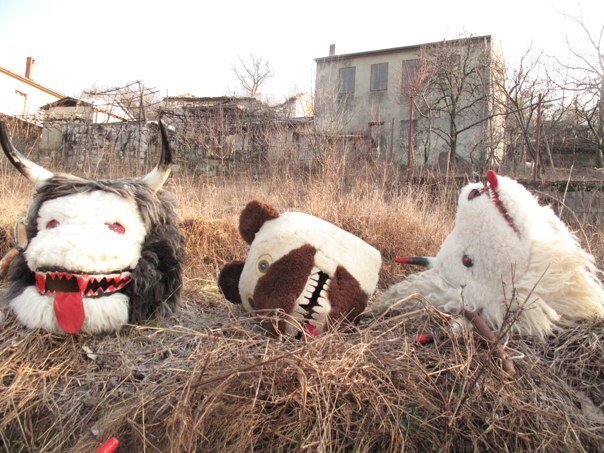

The unmissable outfit of striped sailors shirts, and red bandanas underneath a giant shag of sheepskin is curious, and made somewhat charming rather than menacing by the ample bellies on show. Or perhaps the sense of charm came from how friendly the beasts were, constantly beckoning me into the messy fray.
The essential accessory - a large singular cowbell is lashed to the backside. The requisite noisemaker.
A hand prop in the form of a mace, also stylized, is the final touch.
It is said that these costumes were also useful as a form of protection; scaring off the Ottoman forces. Noisy, stomping horned beasts appearing from the night drove the enemy off, protecting the villages from invasion.
So, every February, men nominated to be Zvončari get kitted up, and prepare for their biggest three days of the year marching from village to village honouring their centuries old tradition. This is a time that brings the villages scattered across the hills together. Equally important as the religious significance at this time of year; is the sense of community spirit that these old traditions reinforce.
Following, and marching along historic routes, as others before have done for centuries; the Zvončari arrive at expectant villages that have laid out a bounty of food and drink. One must feed the beasts, thanking them for the protection, and calling in good luck, prosperity, and fertility. An obvious nod to Pagan rites. In tune with the pre - Lenten consumption, there were tables of sugared and fried fritters, piles of sausages, pastries. The booze was flowing, and the fur flying as the marching band played on.
There were 160 men that day, and it was remarkable to see there was actual order in the chaos. Choreographed madness, that culminated in a series of theatrical rituals upon their arrival at each village that only got more intense as we travelled.
SUPPORTING ROLES
KOMANDANTE
Enter komandante, the flamboyant ring leader and master of ceremonies who plays a vital role in the procession. Dressed in a full white militaryesque suit, adorned with red tassels, and his general’s cap fancied up with feathers and flowers. He conducts the marching band and controls the herd of beasts with a sword. Waving it like a magic wand, and aided by a whistle, he herds and directs the performances of his Zvončari.
And so it was - the shrill bleat of the whistle and like a bunch of sheep-man-cattle creatures, everyone clamoured around grabbing their discarded heads to form a line of pairs for as far as I could see. And suddenly we were off. All 160 of these wildebeests - and us, the willing tag alongs.
THE BELLS
Large cowbells play a major part in setting the scene. Especially effective when there are 160 of them clanging in unison. It was intense, it was chaotic, deafening, and affecting. There was method to the madness though. The men marched in a military like stride, strutting in a way so the bells created maximum noise. I chased along behind, sometimes to be pulled in and along in a sea of sheepskin funnelling its way down a narrowed part of a path.
There were other bit part players that appeared along the way. The crazed doctor wheeling his IV stand along in his mad world, checking peoples chests and heads with his stethoscope. His antics kept me amused for quite awhile.
THE PRANKSTERS
Important interlopers enter the march to shake up the scene.
There is the red horned Devil. A terrorizing blur of black fur that wreaks a frenzied havoc on anything and everything. He rubs charcoal or ash on any victim he can find, especially women and children, also a long standing ritual.
Equally troublesome is the Bear, played by a teenaged man chosen to represent youthful virility - and mischievousness.
As the beasts march and clang on, these pranksters follow on the fringes taunting and teasing the audience lined up along the streets and balconies approaching the villages.
The Bear leaps on everything from cars, to women. Climbing trees, and scaling chimneys, it is all a riotous masquerade of stunts and pranks that wind up to a climax with the marching band, the beasts, and the bells descending upon each expectant village.
THE PUST
The final act. An effigy that represents all the bad, nefarious things from people to politicsfrom the previous winter is burnt as the merriment carries on well into the night in each village.
THE ARRIVAL
Upon arrival at each village there is the shrill sound of the komandant’s whistle and swishing of his sword as the beasts gather around and wind themselves up into an even more deafening cacophony of bellringing…which is followed by a surreal moment of silence as they stand in front of their waiting hosts.
Another blast and they are released to feast, dispersing like frenzied cattle let free from a corral. Monster heads come off, and everyone, beasts and hosts descend on the tables of food and drink in a raucous flurry of fur and shouting.
And just as we are really getting into it. the whistle signals us that we are on the move again. Heads and props are grabbed, drinks guzzled, and we are off marching again.
And we marched, and we ate, and we drank, danced, and marched some more…from village to village for 9 hours. I lost count of the villages, and had lost track of Davor almost immediately, catching occasional glimpses of him through the melee and madness.
The fur sure was flying faster after each village, fueled by endlless rakija, wine, fritters, sausages, and goulash.
Each village stop was different, from one that hosted a live band to the low ceilinged wine cellar with quite a few of us crammed into evert possible corner.
Like one big messy, heaving mass of horns and fur we eventually reached an old timey bus that was waiting to transport the lot of us down to Rijeka to carry on with things.
We careened down and around the sharp bends of the road to Rijeka, the bus like an overstuffed livestock truck that I swear was teetering on two of its wheels on some of the corners. Fur, horns and fists stuck out of the windows pounding the sides of the bus along to the still marching band that was still going strong at the back of the bus.
I had the chance to thank Davor Rostuhar in person years later when we crossed paths by chance again. Here is a link to his incredible photography, books, travels and more.
https://davorrostuhar.com/en/
FESTIVAL & FUN
My personal list of Interesting events and festivals in Croatia by season - there are surely more to be added. There are heaps of music, and film festivals, theatre, and many more religious, cultural events taking place year round in Croatia. Too many to list.
I have handpicked a few of my favourites from ones I have attended and written about in this blog. Festivals are great additions to off season exploring, with many winter, fall and spring festivals that really show the cultural heart and soul of Croatia. In the summer months you will find music, and film festivals taking place everywhere from islands to the capital.
WINTER
ZAGREB ADVENT - winter festival
Zagreb centre
December to early January
Winner of best European winter festival
The entire city comes alive with decorations, squares full of little huts selling mulled wine, food, drink and crafts. Live music, lights and Christmas cheer. A great time to experience Zagreb.
https://www.adventzagreb.hr/?lang=en
OPEN WINE CELLAR DAYSPeljesac Peninsula (Dubrovnik region)
Early December
wineries and cellars open their doors, from end to end of the wine region - Peljesac peninsula. Great fun, find a driver…!
RIJEKA KARNEVALRijeka waterfront and korzo
Frebruary
one of the largest carnivals in Europe
Parade and festivities
https://www.rijecki-karneval.hr/en/
*Samobar & Velika Gorica also have impressive carnival celebrations
SVETI NIKOLA/St. NicholasKomiza, Vis island December 6th
to celebrate St. Nick’s day a wooden boat is hoisted from the sea and hauled up to the church on the hill, piled high with branches and set afire.
Party in the town of Komiza square at night
https://www.tz-komiza.hr/
POKLAD CARNIVAL
Lastovo Town, Lastovo Island
February
Poklad, the main event is on Ash Wednesday
A unique version of carnival on a unique far away island - A straw stuffed mannequin/figure is strung on a wire and flies down through town, representing the capture of an enemy messenger, and the town’s triumph against invasion.
https://tz-lastovo.hr/en/events/lastovos-poklad/
FESTIVAL OF ST. BLAISE - Dubrovnik
February 3rd
celebration of Dubrovnik’s beloved patron saint, Sveti Vlaho/St. Blaise.
The population of Dubrovnik descends upon the Old town dressed in their finest to watch the procession and relics of the saint marched through town. Followed by one big party in the local taverns.
SPRING
STON OYSTER FESTIVAL
Mali Ston, Peljesac Peninsula (Dubrovnik region).
Mid March - St. Joseph’s Day
When oysters are at their best, and on the day of Sveti Josip/St. Joseph, people wake up from the winter and come out from allover the region to gulp and guzzle some of the finest oysters and wine. Good fun. Floating barges full of oyster shuckers, and a barn full of wine. http://www.ston.hr/?l=eng
DAYS OF ASPARAGUS - Istrian peninsula
March - May
Asparagus pops up in the spring allover the hills of Croatia, and is included in specialty dishes, especially in Istria where you will also find festivals for the truffle, pasta, wine, and other delicacies. Check the tourist board websites.
SUMMER
INMusic FESTIVAL ZAGREB - June
a great way to get in on some international A list live bands, and a Zagreb summer vibe all at once. Really great festival on Jarun Lake held over a few days in June.
https://www.inmusicfestival.com/
GARDEN FESTIVAL EVENTS - Tisno - Zadar region
Summer
The famous, iconic Garden, pioneers in music festival events for Croatia, have a series of events all summer long, and a craft brewery of course, with great beer.
https://www.adriaticluxuryvillas.com/blog/upcoming-garden-festival-2021-events-in-tisno-croatia
GOULASH DISKO - Komiza town, Vis Island September mid *still summer to me!
just like its name, a mashup of all sorts of music, art, and sort of hippy beach party on the idyllic far away island of Vis.
http://www.goulashdisko.com/
SINJSKA ALKA - Sinj
early August
to commemorate the victory against the Ottoman army this unique equestrian event and challenge on horseback is singular to Sinj.
SLAMA land art festival, Bilje (Osijek/Slavonian region)
August
artists create large installations, creatures, and art made from plant material. Unique, art festival with all the other good things you find at this kind of festival.
https://www.inlandia.com/special-offers/festivals-events-manifestations/slama-land-art-festival-baranja-croatia.html
MYSTIC MOUNTAIN FESTIVAL
because I must include one festival in the mountains! Fun, nature, music, camping. In one of Croatia’s most incredible parks, Velebit
AUTUMNTRUFFLE DAYS OF ISTRA - Istrian peninsula October is all about the truffle - tasting, hunting, specialties amongst all the other Istrian specialties to indulge in paired with the fabulous wines. Check with the local tourist offices.
DUBROVNIK GOOD FOOD FESTIVAL - October Dubrovnik
Dubrovnik restaurants feature special al a carte menus, street food stands pop up, and workshops regarding local food and traditions are on offer. Highlight event is the enormous table of food that runs the length of the Stradun displaying local chef and restaurant goodies. Bit of a feeding frenzy…but good people watching. I saw a lady pop small cakes in her purse!
https://www.timeout.com/croatia/things-to-do/good-food-festival-dubrovnik
KINOOKUS FILM FOOD FESTIVAL - Mali Ston Peljesac Peninsula - Septemberhttp://www.kinookus.hr/index.php/en/
A great food centric film festival with lots of soul, focussed on the wide world of food, culture, slow food, wines etc. and it takes place on the wonderful Peljesac peninsula, in Mali Ston, and Ston.
SPLIT PICIGIN FEST - Bacvice beach, Split - September *check with tourist board or at beach!
a dynamic handball game created, and played in the sandy shallows of Bacvice beach. Great people watching!
VINKOVCI AUTUMN FESTIVAL
Vinkovci, Slavonian region
an often overlooked region, Slavonia is wonderful for food, wine, agro-tourism, and cultural heritage, which is all found at this fall festival.
https://www.timeout.com/croatia/things-to-do/vinkovci-autumn-festival




